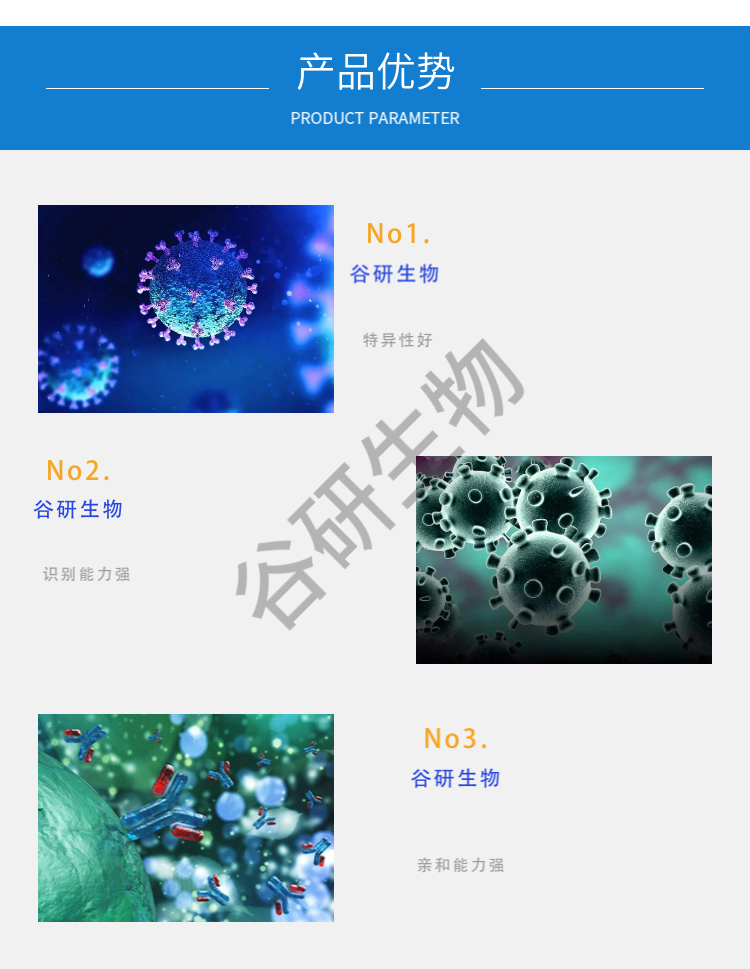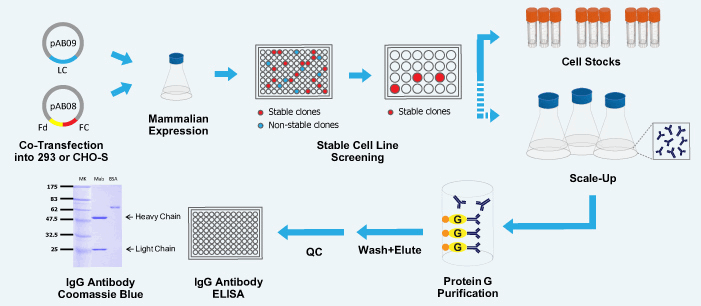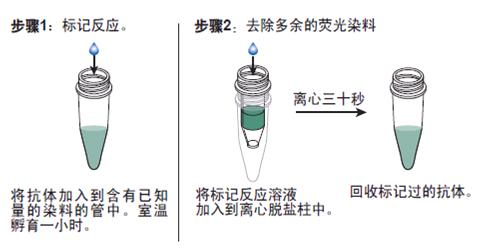 欢迎来到上海谷研实业有限公司网站!
欢迎来到上海谷研实业有限公司网站! 咨询电话:18321818584
咨询电话:18321818584 欢迎来到上海谷研实业有限公司网站!
欢迎来到上海谷研实业有限公司网站! 咨询电话:18321818584
咨询电话:18321818584产品分类
Product Category相关文章
Related Articles详细介绍
商品属性:
货号 | 产品名称 | 规格 |
GOY-01K0189 | β淀粉样肽1-42单克隆抗体 | 50ul |
GOY-01K0189 | β淀粉样肽1-42单克隆抗体 | 100ul |
GOY-01K0189 | β淀粉样肽1-42单克隆抗体 | 200ul |
英文名称: beta-Amyloid (1-42)
中文名称: β淀粉样肽1-42单克隆抗体
别 名;beta Amyloid(1-42); beta Amyloid 1-42;
beta-Amyloid 1-42; Amyloid 1-42; P3(42); A4; AAA; ABETA; ABPP; AD1; Alzheimers
Disease Amyloid Protein; Amyloid B; Amyloid Beta A4 Protein Precursor; Amyloid
Beta; Amyloid of Aging and Alzheimer Disease; APP; APPI; B Amyloid; Beta APP;
Cerebral Vascular Amyloid Peptide; CTFgamma; CVAP; PN II; PN2; PreA4; Protease
nexin II; A beta; A4_HUMAN; Beta-amyloid protein 42.
研究领域;细胞生物 免疫学 神经生物学 Alzheimer's
抗体来源;Mouse
克隆类型;Monoclonal
克 隆 号2E5
交叉反应;(predicted: Human, Mouse, Rat,
)
产品应用;WB=1:500-2000
ELISA=1:5000-10000
not yet tested in
other applications.
optimal dilutions/concentrations
should be determined by the end user.
理论分子量;4.4kDa
细胞定位;细胞核 细胞浆 细胞膜 细胞外基质
性 状;Liquid
免 疫 原;KLH conjugated synthetic
peptide derived from human beta-Amyloid: 672-713/770 or 1-42/42
亚 型;IgG2b
纯化方法;affinity purified by Protein A
缓 冲 液;0.01M PBS(pH7.4)
注意事项;This product as supplied is
intended for research use only, not for use in human, therapeutic or diagnostic
applications.
产品介绍 The cerebral and vascular
plaques associated with Alzheimer's disease are mainly composed of Amyloid beta
peptides. beta Amyloid is derived from cleavage of the Amyloid precursor
protein and varies in length from 39 to 43 amino acids. beta Amyloid [1-40],
beta Amyloid [1-42], and beta Amyloid [1-43] peptides result from cleavage of
Amyloid precursor protein after residues 40, 42, and 43, respectively. The
cleavage takes place by gamma-secretase during the last Amyloid precursor
protein processing step. beta Amyloid [1-40], beta Amyloid [1-42], and beta
Amyloid [1-43] peptides are major constituents of the plaques and tangles that
occur in Alzheimer's disease. beta Amyloid antibodies and peptides have been
developed as tools for elucidating the biology of Alzheimer's disease.
Functions as a cell surface receptor and performs physiological functions on the surface of neurons relevant to neurite growth, neuronal adhesion and axonogenesis. Involved in cell mobility and transcription regulation through protein-protein interactions. Can promote transcription activation through binding to APBB1-KAT5 and inhibits Notch signaling through interaction with Numb. Couples to apoptosis-inducing pathways such as those mediated by G(O) and JIP. Inhibits G(o) alpha ATPase activity (By similarity). Acts as a kinesin I membrane receptor, mediating the axonal transport of beta-secretase and presenilin 1. Involved in copper homeostasis/oxidative stress through copper ion reduction. In vitro, copper-metallated APP induces neuronal death directly or is potentiated through Cu(2+)-mediated low-density lipoprotein oxidation. Can regulate neurite outgrowth through binding to components of the extracellular matrix such as heparin and collagen I and IV. The splice isoforms that contain the BPTI domain possess protease inhibitor activity. Induces a AGER-dependent pathway that involves activation of p38 MAPK, resulting in internalization of amyloid-beta peptide and leading to mitochondrial dysfunction in cultured cortical neurons. Beta-amyloid peptides are lipophilic metal chelators with metal-reducing activity. Bind transient metals such as copper, zinc and iron. In vitro, can reduce Cu(2+) and Fe(3+) to Cu(+) and Fe(2+), respectively. Beta-amyloid 42 is a more effective reductant than beta-amyloid 40. Beta-amyloid peptides bind to lipoproteins and apolipoproteins E and J in the CSF and to HDL particles in plasma, inhibiting metal-catalyzed oxidation of lipoproteins. Beta-APP42 may activate mononuclear phagocytes in the brain and elicit inflammatory responses. Promotes both tau aggregation and TPK II-mediated phosphorylation. Interaction with overexpressed HADH2 leads to oxidative stress and neurotoxicity. Appicans elicit adhesion of neural cells to the extracellular matrix and may regulate neurite outgrowth in the brain. The gamma-CTF peptides as well as the caspase-cleaved peptides, including C31, are potent enhancers of neuronal apoptosis. N-APP binds TNFRSF21 triggering caspase activation and degeneration of both neuronal cell bodies (via caspase-3) and axons (via caspase-6).

实验流程:

(1)特异性结合抗原:抗体本身不能直接溶解或杀伤带有特异抗原的靶细胞,通常需要补体或吞噬细胞等共同发挥效应以清除病原微生物或导致病理损伤。然而,抗体可通过与病毒或毒素的特异性结合,直接发挥中和病毒的作用。
(2)活补体:IgM、IgG1、IgG2和IgG3可通过经典途径激活补体,凝聚的IgA、IgG4和IgE可通过替代途径激活补体。
(3)结合细胞:不同类别的免疫球蛋白,可结合不同种的细胞,参与免疫应答。
(4)可通过胎盘及粘膜:免疫球蛋白G(IgG)能通过胎盘进入胎儿血流中,使胎儿形成自然被动
免疫。免疫球蛋白A(IgA)可通过消化道及呼吸道粘膜,是粘膜局部抗感染免疫的主要因素。
(5)具有抗原性:抗体分子是一种蛋白质,也具有刺机体产生免疫应答的性能。不同的免疫球蛋白分子,各具有不同的抗原性。
(6)抗体对理化因子的抵抗力与一般球蛋白相同:不耐热,60~70℃即被破坏。各种酶及能使蛋白质凝固变性的物质,均能破坏抗体的作用。抗体可被中性盐类沉淀。在生产上常可用硫酸铵或硫酸钠从免疫血清中沉淀出含有抗体的球蛋白,再经透析法将其纯化。
抗体的制备过程:
1.免疫原:普通的大分子蛋白,通过分子克隆构建载体并在大肠杆菌中进行诱导表达获得重组蛋白,纯化鉴定后可直接作为免疫原;小分子蛋白或化合物等分子量小,需要偶联载体对该分子进行改造才能使其成为具有免疫原性的抗原,常见偶联载体如BSA、OVA、HAS等。
2. 免疫动物:常用于制备抗血清的动物有豚鼠、家兔、鸡、大小鼠等,大量生产时需要用到狗、绵羊、山羊等。

3.免疫血清的收集:一般家兔、绵羊、山羊可采用静动脉采血,家兔、豚鼠、大鼠、鸡可采用心脏采血,家兔、山羊、绵羊可采用静脉采血。
4. 免疫血清的纯化与鉴定:得到的抗血清需要进一步的纯化,利用偶联了抗原的亲和柱进行层析,具有高效,特异性强,纯度高的特定。接着要鉴定纯化蛋白的含量、相对分子的质量、纯度以及特异性。
5.β淀粉样肽1-42单克隆抗体免疫血清的保存:抗体一般比较稳定,在-80℃ ~-20 ℃可以保存约5年而不会影响效价,而真空干燥保存时间可以更久。保存前需经除菌并添加防腐剂。
产品咨询
电话
微信扫一扫
